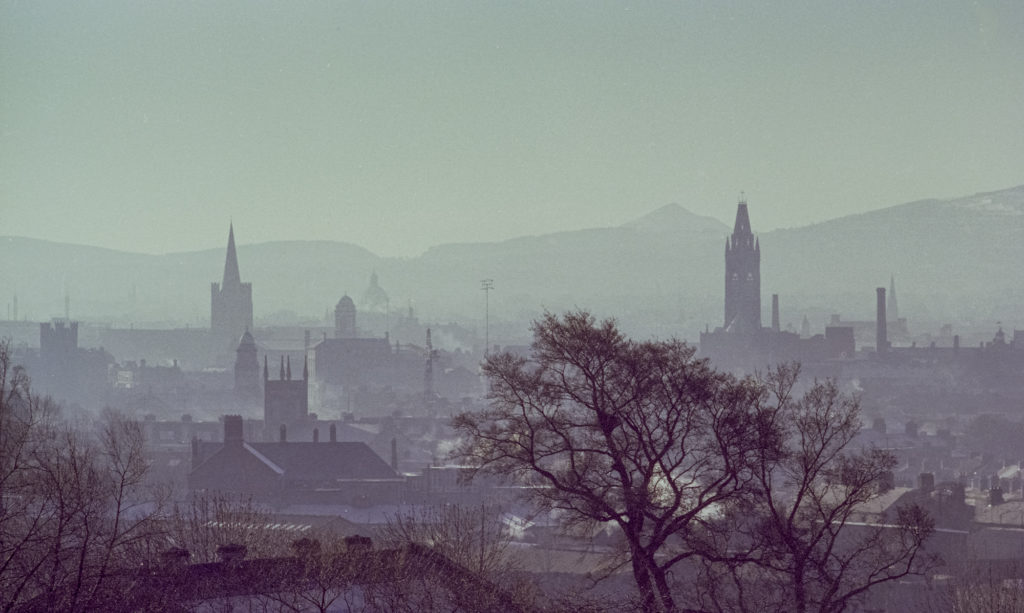My first job found me working in Sharjah in the UAE. Thwarted for years, I carelessly used most of my fourth monthly paycheck to buy the state of the art Canon A-1 in 1979, taking advantage of the freedom from purchase taxes in neighbouring Dubai. Friends and colleagues were buying the more affordable AE-1 but I thought I’d likely hold onto the camera for a decade so I went for the A-1; future proofing was the justification for acquiring this object of professional desire, with its better viewfinder, faster shutter speeds and exposure compensation. It was worth it because the A-1 made me out to be a better photographer than I had been. And it helped that there was often more sunlight in the desert than in Ireland.

Scan from film negative January 1980 – Canon A-1
191 N Circular Rd, Phibsborough, Dublin.
Of course the future wasn’t what I expected. I had come to realise I was in the wrong job in Sharjah so I headed back to Ireland, fell in love, got a new career, got married, pregnant, lost my job and then emigrated to the US to take up a new job. Impending immigrant poverty suggested that photography would be unaffordable for a while, if not longer! My father was a keen photographer, and better than me so I had given him the A-1 as a present. I have some of his photo albums and I can see that he used it for a couple of years until his home was burgled. The albums illustrate that his interest in photography was expanding and then it just stops, stolen from him along with the camera. Thereafter, he carried a cheap camera as a tool for making memories.
Meantime, we were back using Kodak Instamatics or their equivalent to document our children’s early years in the US. Then Kodak came out with a very compact disc film camera. So compact and thin that it fitted in a pocket almost like a phone does today. Easy to load/unload, it was fully automated, perfectly suited to life with babies. The negatives are incredibly small and awkward to print or scan.
Then we braved an Olympus XA compact 35 mm; small, robust, mostly manual and convenient. It’s still with us though we’ve not used it for a decade or two. Eventually, perhaps a decade after buying the XA, I was passing through Singapore and I bought a Chinon Genesis III. A so called ‘bridge camera’, it was a semi-automated SLR with a zoom lens. It ate batteries and became a permanent home for viewfinder moulds during Burmese monsoons. But it did a good job in my ever travelling suitcase, also laden with spare batteries. It was time to replace it when the film advance mechanism started scratching the negatives but we had six good years service from it. And so 1997 is when we went digital.
That was because the digital video bug hit me. Lia agreed that I buy a Sony Camcorder at great expense. It could also take digital stills and even had an infra-red mode. The digital stills were here to stay. And that Sony DCR-PC350E gave us eleven years of really good service. We have a drawer full of 4 mm magnetic tapes and I still stumble over those chewing-gum-like Sony memory sticks. I have to add that the challenge in home video back then was that a three minute video could take five days to edit. Inevitably, video edit fatigue set in.
It was time to go back to Canon SLR, fully digital and heading above 12 megapixels (the same as the 2019 iPhone 11 in my pocket). Back in 2008, I wanted to be making more than memories and believe it or not, I bought the Canon 450D with points from a charge card loyalty scheme.
I had bought an Epson scanner in 2007, around the time I was getting ready to go back to SLR. The same scanner is on the desk beside me in 2020.
By simonscarves at FabHappy
I spent many an evening over five years scanning several hundred rolls of developed film. One or two rolls a night, two or three sessions a week. Each scan took about 45 minutes, the negatives arranged in a plastic frame that held up to 36 frames at once. I experimented and learned that it was best to scan at 4800 dots per inch which created 20 MB TIFF files. The dust, the scratches, the spittles, they all show up huge at the scale of 35 mm negatives.
The Canon 450 locked me into interchangeable but Canon fit lenses. The 450 gave way to a 5D before I couldn’t resist the low-light performance temptations of the 1D-X. The lenses moved from one to the next. Now the same lenses are working on the Fuji X-T3.
It takes time to build any capability. And patience, persistence and optimism. Photography needs them all and more besides.



Leave a Reply